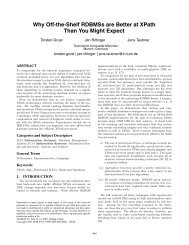Chapter 10 The Traveling Salesman Problem
Chapter 10 The Traveling Salesman Problem
Chapter 10 The Traveling Salesman Problem
You also want an ePaper? Increase the reach of your titles
YUMPU automatically turns print PDFs into web optimized ePapers that Google loves.
Ej = E ∪{x<br />
}<br />
Ii - I ∪{x<br />
, x ,..., x<br />
1<br />
j<br />
2<br />
j-1<br />
⎪⎫<br />
⎬ k = 1,2,..,j <strong>10</strong>.30<br />
} ⎪⎭<br />
But xj is an excluded arc of the jth sub-problem and an included arc in the (j+1)st problem. This<br />
means that a tour produced by the (j+1)st problem may have the xj arc but a tour produced by the<br />
jth problem may not contain the arc. This means that the two problems cannot generate the same<br />
tours, as they cannot contain the same arcs. This guarantees that there are no duplicate tours.<br />
Complexity of the branch and bound algorithm.<br />
<strong>The</strong>re has been a lot of controversy concerning the complexity of the branch and bound<br />
algorithm. Bellmore and Malone have stated that the algorithm runs in polynomial time. <strong>The</strong>y<br />
have treated the problem as a statistical experiment assuming that the ith try of the algorithm is<br />
successful if it finds a minimal tour for the Ith sub-problem. <strong>The</strong>y assumed that the probability of<br />
the assignment problem to find the solution to the asymmetric traveling salesman problem is e/n<br />
where n is the number of the cities. Under other assumptions, they concluded that the total<br />
number of sub-problems is expected to be:<br />
∑ ∞<br />
i=1<br />
ipi ∏ − i 1<br />
1−<br />
pj ≤ (1-p<br />
j=<br />
0<br />
∑ ∞<br />
ipo<br />
i=1<br />
o) i-1 = 1\po = O(n). <strong>10</strong>.31<br />
Smith concluded that under some more assumptions the complexity of the algorithm is<br />
O(n 3 ln(n))<br />
<strong>The</strong> assumptions made to reach this result are too optimistic. Below it will be proven that they do<br />
not hold and that the complexity of the branch and bound algorithm is not polynomial.<br />
Definition:<br />
<strong>The</strong> assignment problem of a cost matrix with ci,j = ∞ is called a modified assignment problem.<br />
Lemma <strong>10</strong>.1:<br />
Assume a n x n random cost matrix. Consider the assignment problem that has s0, <strong>10</strong>.33<br />
where λ,






